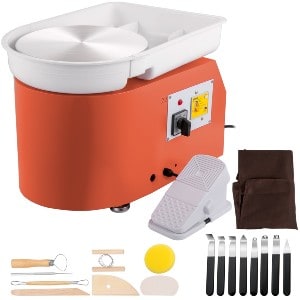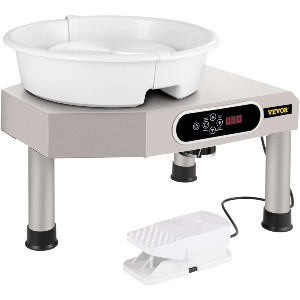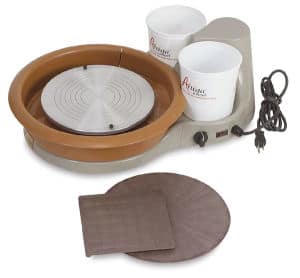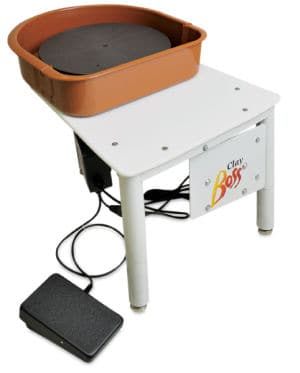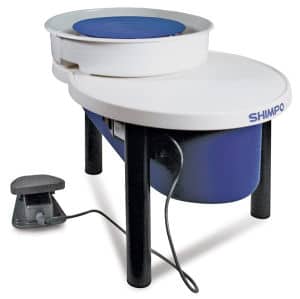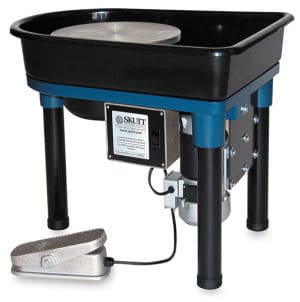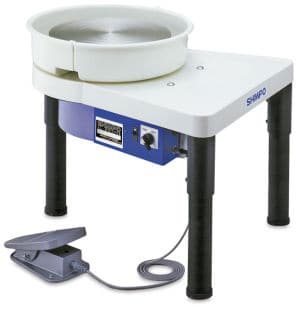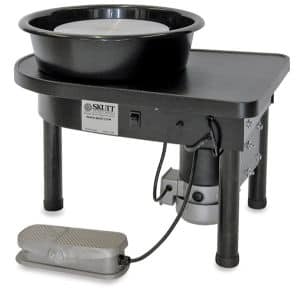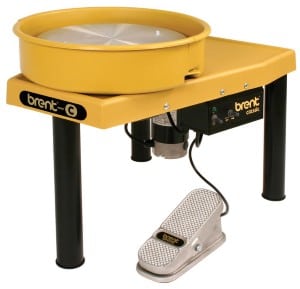Your cart is currently empty!
How Much Does a Pottery Wheel Cost? – Buyers Guide
Published:
Last Updated:
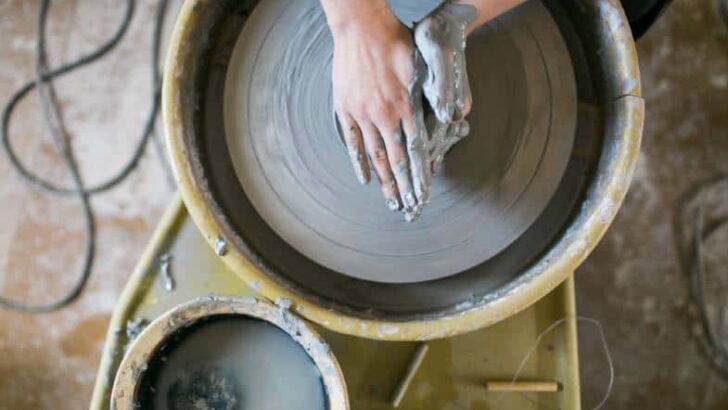
Affiliate Disclaimer
As an affiliate, we may earn a commission from qualifying purchases. We get commissions for purchases made through links on this website from Amazon and other third parties.
When I bought my first wheel, I wasn’t sure how it was going to fit into my life or home. I didn’t want to spend a lot of money on something that I simply didn’t get a chance to use. I did some research at the time and one of my key questions was how much does a pottery wheel cost? This is what I found out…
There are pottery wheels available to suit all budgets and levels of skill. Pottery wheels range in cost from around $200-$2000. You might worry that if you go in at a budget level you are getting something second-rate. However, you can get a reasonably priced wheel that works well.
When you are buying a pottery wheel, there are a few things to consider. Price is definitely one of them. In my review of some pottery wheels available to buy, I will arrange them in order of cost. However, the cost isn’t the only factor to consider. So, I will also give you an overview of some other features to bear in mind.
How Much Does a Pottery Wheel Cost – Price Ranges
This review is organized into 3 price ranges. There is quite a bit of price variation within each range. However, if you know what your budget is, you can click on one of the links below to go directly to that section…
As well as cost, here are some other features to take into consideration when buying a pottery wheel.
Key Factors Other than the Cost of a Pottery Wheel:
These are some features that I have found to be important when using a pottery wheel. It’s good to have an idea of why these features are important when you decide which wheel to buy…
Wheel Head Diameter
The wheel head on a pottery wheel is the circle of metal that you throw your pots on. These range in size on pottery wheels. Ranging between 8 and 14 inches in diameter.
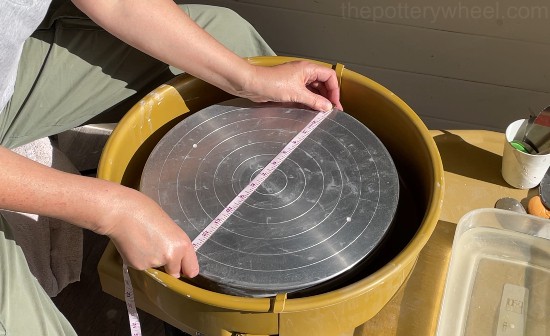
The larger the wheel head, the larger the pieces of pottery you can throw. A smaller wheel head of around 10 inches is normally fine if you are just starting out.
Bat Pin Holes / Bat Pins
Bats are flat pieces of wood, plaster, or plastic, that you can attach to your wheel head. They are a good addition to a pottery wheel for a few reasons.
One advantage of a bat is that when you’ve finished your piece you can lift the bat off the wheel. Then you can put it to one side to let it dry. This means you can avoid having to cut and lift the pottery off when it is still soft.
Pat pins are the screws that hold the bat in place. Bat pin holes are the holes in the wheel head that you screw into.
Not all wheel heads have bat pin holes. It’s not the end of the world if your wheel head does not have bat pin holes. I used a wheel without a bat for years. But it’s worth bearing in mind as a feature.
Height of Wheel
Consider how tall the wheel is. Will it be the right height for you? If not, does it have adjustable legs? Or could you fit leg extenders?
Forward and Reverse Function?
Does the wheel head rotate clockwise and counterclockwise? It’s often said that right-handed people find it easier to throw when a wheel is going counterclockwise. Conversely, left-handed people often find a clockwise pottery wheel direction easier. Though there are always exceptions to this preference, reversibility is a useful feature.
Does it Have a Foot Pedal?
Some of the unbranded pottery wheels that cost less don’t have a foot pedal and are lever-operated. Both can work well, but you may have a personal preference as to what you want.
How Powerful is the Pottery Wheel?
Electric pottery wheels are run by a motor. The strength of a pottery wheel is often gauged by the amount of clay it can center. This ability depends on the amount of torque the motor generates. Torque is a turning force that causes an object to rotate around an axis (source).
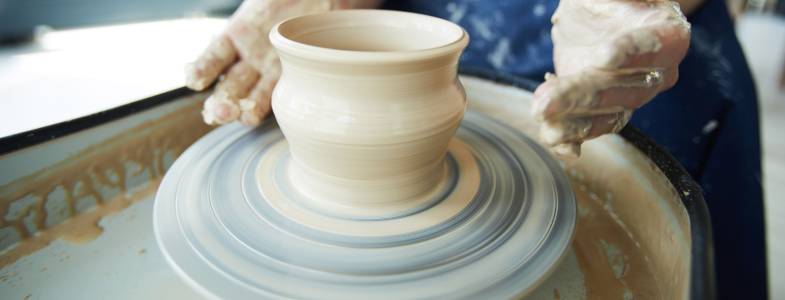
Horsepower is torque multiplied by RPM. So, although it is largely torque that determines a wheel’s centering capacity, horsepower can be an indicator. Horsepower is designated in fractions such as ¼ HP or ½ HP.
Generally, the more horsepower a pottery wheel motor has, the more clay you will be able to center. When you are centering clay you have to exert some force, ideally using your body weight. There is quite a bit of resistance between you and the clay.
The larger the piece of clay the harder the wheel has to work to cope with the resistance. If the wheel lacks torque it will slow down significantly when larger pieces of clay are being thrown. A stronger wheel will be able to keep up with the work involved in centering more clay.
If you are making medium-sized bowls, cups, and plates, you don’t need a bionic wheel. A wheel with about ¼ HP would be fine. But if you intend to go large with your pottery, your wheel will need more HP. And higher HP pottery wheels normally cost more.
So, if you’re wondering how much does a pottery wheel cost, you need to consider wheel power too.
The Splash Pan
The splash pan is the bowl that fits around the wheel head. It catches water, slip, and clay. Splash pans get messy quickly. It’s good if they come apart easily and can be cleaned.
Some wheels have a two-piece splash pan, which comes apart. Others have a one-piece splash pan that can be lifted off the wheel shaft.
Noise Levels
It is also worth considering how much noise a pottery wheel generates. Particularly if you work in a shared studio, or have family members or housemates who are sensitive to noise!
Weight
If you want a wheel that is portable, weight is obviously a factor. Perhaps you envisage taking your pottery wheel into the backyard on a sunny day. But even if you don’t, you might need to slide it from one side of the studio to the other. In this case, the weight of your pottery wheel is worth thinking about.
So, though a key question might be how much does a pottery wheel cost, these are important considerations. That being said, you will most likely find something that meets your needs in your price range. And, if you find a pottery wheel that you love, it really is the start of a beautiful friendship!
So, How Much Does a Pottery Wheel Cost?
Bearing in mind some of the factors described above, let’s have a look at the different price ranges…
Budget Pottery Wheels – Costing Under $300
If your key consideration is how much does a pottery wheel cost, then chances are you’re on a budget. This section is all about budget wheels, so read on…
Wheels under $300 are generally unbranded. The models that I have reviewed below are listed with names. However, these are the names of the sellers rather than the wheel.
Nevertheless, I wouldn’t let the fact that they are unbranded put you off. Both of these low-cost options have some real plus points.
Model 1) Table Top Budget Pottery Wheel
This pottery wheel is very compact. The height of the unit from its feet to the wheel head is 13.8”. This means that unless you are a child or very petite, it will work much better on a tabletop.
Although it isn’t sold as a tabletop pottery wheel, this is the way I would think of it. You would just need to find a table that brought the wheel head up to the right height for you.
Check out my post about the best height for your pottery wheel. This article should help you work out what table height you’d need with this wheel.
Important point! Be aware when you are selecting this wheel that some models come with a foot pedal and some don’t.
You have to look at the image when you are choosing which one to put in your basket. Some have a foot pedal and others have a hand control lever.
I made the mistake of buying a wheel with a hand lever when I actually wanted a foot control version. Some potters prefer the hand lever, but I’m used to using a foot pedal.
It was fine in the end, and I was able to return and replace it. But it was a pain to organize. So, it’s just something to be aware of!
Overall: This is a good beginner’s wheel. It is compact, easy to clean, and not too noisy. In addition, it is quite strong for its size, putting out about 1/4HP.
You would be able to center up to around 5 lbs of clay on this pottery wheel without trouble. That is enough clay for a decent-sized mug, plate, or bowl.
Plus it comes with a selection of pottery tools and trimming tools. So, if you’re wondering how much does a pottery wheel cost, the answer can be… not much!
Table Top Budget Wheel Specification
| Feature | Details |
| Wheel Head Diameter | 11″ |
| Bat Pins | No |
| Height of Wheel Head | 13.8″ |
| Forward / Reverse | Yes |
| Foot Pedal | Optional |
| Clay capacity | Up to 5 lbs |
| Splash Pan | 2 piece |
| Noise Levels | <60db |
| Weight | 33 lbs |
| RPM | 0-300 rpm |
| Horsepower | 1/4 HP |
Model 2) Free-Standing Budget Pottery Wheel
This is also a very compact pottery wheel. It weighs in at around 33lb and the dimensions are only 22 x 16 x 14.5″. As a result, you can easily store this wheel without much difficulty in most homes or studios.
With the wheel head 14.5″ from the ground, it is quite short. So, it is perfect for kids, or petite adults. Or it can be used on a small coffee table for taller adults who need more height.
However, unlike a tabletop pottery wheel, this wheel has legs. This means that if you want to make it higher, you can simply put it on risers.
My first pottery wheel had this exact same design, and I used bed risers to bring the height up. Check out my article here on how to boost the height of your pottery wheel if you are tall.
This upgraded model of the free-standing Vevor pottery wheel also has an LCD Touch Screen controller. This is great for when you are operating the wheel with wet clay hands!
From personal experience, I can really recommend this wheel as a starter wheel. It’s a great little wheel, with a surprisingly powerful motor.
The motor has enough torque that you can center clay quite easily. It doesn’t slow down when you are centering clay. I found it managed well with up to 10 lbs of clay.
It is not designed to throw really big pieces like great big platters or vases. However, if you want to make cups, bowls, plates, and normal-sized vases or jugs, this wheel is perfect.
It’s easy to clean and light in weight, so once you have finished your session, you can clean up and slide it out of the way. Mine was tucked in the corner of my kitchen for a few years.
Free Standing Budget Wheel Specification
| Feature | Details |
| Wheel Head Diameter | 9.8″ |
| Bat Pins | No |
| Height of Wheel Head | 14.5″ |
| Forward / Reverse | Yes |
| Foot Pedal | Yes |
| Clay capacity | 6-7 lbs |
| Splash Pan | 2 piece |
| Noise Levels | <50 dB |
| Weight | 33 lbs |
| RPM | 0-300 rpm |
| Horsepower | 1/4 HP |
How Much Does a Pottery Wheel Cost in the Mid-Range?
If you have a little more to spend, the following might be the right price range for you…
Pottery Wheels Costing $300-$1000
One of the most reasonably priced pottery wheels in the mid-range is the Artista by Speedball
Model 3) Speedball Artista Pottery Wheel
Speedball makes a few pottery wheels. The Artista is the most economical from a cost point of view. And it is also very versatile. It is designed to be portable, so you can move it from room to room. You can also take it to and from the studio, or throw pottery outside if it’s a nice day. Perfect.
For a compact, lightweight pottery wheel it is powerful and is able to center up to 25lb of clay.
Although it’s portable, it is solid and you need not worry about it moving around as you center your clay. It stays put and does not slide across the table surface.
There are a few features that it’s good to be aware of.
Firstly, out of the box, it has a hand-operated speed control. There is a knob on the side that you turn to adjust the speed.
However, if you want it to be foot-operated, it is easily converted with a plug-in foot pedal. You can buy the foot pedal separately, directly from Speedball. However, I found it at a discounted cost at Bailey Ceramic Supplies.
Likewise, by default, it is a tabletop pottery wheel without legs. However, you can buy leg sets specifically made for the Artista. These will convert it into a free-standing unit.
The last thing to be aware of with the Artista is that it does not have a reverse function. But you can buy either a standard (right-handed) wheel or a left-handed one. You make this selection at the point of purchase.
Artista Specification
| Feature | Details |
| Wheel Head Diameter | 11″ |
| Bat Pins | Yes |
| Height of Wheel Head | 9″ |
| Forward / Reverse | No |
| Foot Pedal | Sold Separately |
| Clay capacity | 25 lbs |
| Splash Pan | 2 piece |
| Noise Levels | Not specified |
| Weight | 28 lbs |
| RPM | 0-220 rpm |
| Horsepower | 1/4 HP |
Model 4) Speedball Clay Boss
The Speedball Clay Boss is the first in the mid-cost range that has a free-standing design. With a horsepower of ½ HP it can easily center up to 100lb of clay. So, it is a powerful piece of pottery kit for a really reasonable price.
Because it has a 14” wheel head you have more scope for throwing larger pieces too.
The advantage of the Clay Boss over the Artista is that it does have a reverse function.
The reverse function can come in very handy, especially when trimming your pottery.
So, having the option to reverse your wheel is definitely a bonus.
The Clay Boss costs a bit more than the Artista. However, with the Clay Boss, you don’t have the additional expense of the optional free-standing legs and foot pedal.
It also has ‘load sensing control,’ which means that the wheel adapts to the weight of the clay you’re using. As you use different quantities of clay, the wheel registers the change in weight and will adjust its performance. The upshot of this is that the wheel head maintains its speed under different weights of clay. Basically, it doesn’t slow down and struggle as you use more clay.
In addition, you get 2 free plastic bats, a circular one and a square one. Bonus!
Speedball Clay Boss Specification
| Feature | Details |
| Wheel Head Diameter | 14″ |
| Bat Pins | Yes |
| Height of Wheel Head | 19.5″ |
| Forward / Reverse | Yes |
| Foot Pedal | Yes |
| Clay capacity | 100 lbs |
| Splash Pan | 2 piece |
| Noise Levels | Not Specified |
| Weight | 83 lbs |
| RPM | 0-240 rpm |
| Horsepower | 1/2 HP |
Model 5) Shimpo VL Lite
The Shimpo VL Lite weighs just 51lbs, which makes it one of the lightest free-standing pottery wheels. This is great if you need some flexibility with where you position your wheel.
It is however very sturdy enough to throw on. Shimpo pottery wheels have a reputation for being quiet.
This is great if you are in a classroom scenario with lots of pottery wheels going on at the same time. If you have a few wheels generating noise at once, it can be hard to hear yourself think.
Likewise, if you are someone who likes to throw in a very serene, quiet studio, then a Shimpo wheel might suit you very well.
However, they don’t have as much torque as some of the other leading brands.
As a result, they have a somewhat lower centering capacity of around 25 lbs of clay. This is an issue if you are someone who likes to throw massive pieces.
On the other hand, 25 lbs of clay is more than adequate for the majority of potters. This is especially true if you are buying your first pottery wheel.
Some Other Features of the Shimpo VL Lite
One of the handy things about the Shimpo VL Lite is that the legs are adjustable. This means you can alter the height of your wheel easily. The legs are also removable, so the wheel can be converted for tabletop use. Removing the legs also makes storage easier.
However, whilst the wheel does have bat pins, it is not sold with any bats. The bat pins are standard size, so they will be easy to buy. But it’s worth being aware that this is an additional expense.
Also, whilst you can change the direction of the wheel head, you can’t do this at the flick of a switch. The direction of the wheel head has to be reset. This is a simple process, but it does involve switching off and unplugging the wheel.
Once the wheel is off you remove a switch guard and change the switch position before replacing the guard. When the guard is back on, you can power your wheel back up again.
Shimpo VL Lite Specification
| Feature | Details |
| Wheel Head Diameter | 12″ |
| Bat Pins | Yes |
| Height of Wheel Head | 21″ |
| Forward / Reverse | No (see above) |
| Foot Pedal | Yes |
| Clay capacity | 25 lbs |
| Splash Pan | 2 piece |
| Noise Levels | Not specified |
| Weight | 51 lbs |
| RPM | 0-250 rpm |
| Horsepower | 1/2 HP |
How Much Does a Pottery Wheel Cost in the Higher Price Range?
Perhaps this is your second wheel. Or perhaps you are new to pottery and want to give yourself the best chance at doing well. If so, then, you will most likely find something to suit your needs in this section…
Pottery Wheels Costing $1000-$2100
If you want to push the boat out, you may want to consider one of the following…
Model 6) Skutt Thomas Stuart Legend
The general points made above about Skutt wheels also apply to the Thomas Stuart Legend. In short, Skutt pottery wheels are solid, strong, and very well made.
The Thomas Stuart Legend has a very large removable splash pan. Because it is large, it holds a lot in terms of slip and trimmings.
And it is easy to remove by twisting off the wheel head and lifting the pan off the wheel shaft.
Like the Prodigy, the Legend has a continual duty motor. This enables it to handle really large quantities of clay without the motor getting hot and losing torque.
It also has a heavy-cast aluminum foot pedal which lends to the overall experience of solidity.
Potters who own Skutt pottery wheels tend to be passionate about how great they are. If you like to throw big, then a Thomas Stuart Legend is a great investment.
Skutt Thomas Stuart Legend Specification
| Feature | Details |
| Wheel Head Diameter | 14″ |
| Bat Pins | 10″ pins |
| Forward /Reverse | Yes |
| Foot Pedal | Yes |
| Clay Capacity | 400 lbs |
| Splash Pan | 1 piece |
| Noise Levels | Not specified |
| Weight | 117 lbs |
| RPM | Not specified |
| Horsepower | 1/4 HP |
Model 7) Shimpo VL Whisper
As the name suggests, the Shimpo VL Whisper is very quiet. In fact, some potters find it eerily quiet. It’s a bit like an electric car. You don’t know it’s there until you get a fright when you turn around and see it creeping up behind you. Not that your pottery wheel will be creeping anywhere, but you get my point.
Some potters like to hear the sound of their wheel working, in which case, this may not be the wheel for you. But if you like tranquillity then it is ideal.
Another nice feature of the VL Whisper is that at 0 rpm, you can turn the wheel head turns freely.
This means that you can use it as a banding wheel.
Using a wheel head as a banding wheel is a handy feature for lots of things like applying underglaze or glaze. Or for generally spot-checking your pottery for unevenness.
One of the problems sometimes cited by potters about the Shimpo pottery wheel is that they lack torque. It’s difficult to know why this would be the case. They have a direct drive motor, rather than a belt drive and direct drives generally have more torque. The manufacturers specify that they can handle up to 100 lbs of clay.
Nevertheless, there is anecdotal evidence to suggest that the Shimpo struggles with clay in this quantity.
The Shimpo VL Whisper is a very popular choice. Whether it is the right one for you depends on what you are looking for.
If you are looking for a quiet, refined pottery wheel, at a reasonable cost this might be for you. It has a reputation for being a sensitive, responsive machine. If you’re looking for a solid workhorse that can handle huge chunks of clay, this may not be the one.
Shimpo VL Specification
| Feature | Details |
| Wheel Head Diameter | 14″ |
| Bat Pins | Yes |
| Height of Wheel Head | 23.22″ |
| Forward / Reverse | Yes |
| Foot Pedal | Yes |
| Clay capacity | 100 lbs |
| Splash Pan | 2 piece |
| Noise Levels | Not specified |
| Weight | 122 lbs |
| RPM | 0-250 rpm |
| Horsepower | 1/2 HP |
Model 8) Skutt Thomas Stuart Prodigy
Skutt is one of the leading pottery wheel brands. They produce a few models. The Prodigy is the least expensive and newest addition to their Thomas Stuart range.
Their pottery wheels have a reputation for being well-made, solid, and strong.
In general, their pottery wheels have large wheel head shafts, so they can cope with throwing larger pottery. And they have heavy frames which stop them from sliding when you are working.
The bearings that enable the wheel head to rotate are heavy-duty. And though Skutt don’t give a DB noise reading for their wheels, the robust bearings mean they are quiet.
Another feature of Skutt pottery wheels is that they have large motors. The benefit of a large motor is that it will improve the torque capability.
Skutt uses Continual Duty Rated Motors, which are large and dissipate heat that would otherwise reduce torque. If a motor gets hot, it is less able to handle torque. A Skutt motor also has a fan to help the unit cool and preserve power.
As a result, Skutt states their wheels have more torque at the wheel head than other brands.
Features of The Thomas Stuart Prodigy Pottery Wheel
This particular model has the same usual features of a Skutt wheel, however, it is made on a steel frame.
The Prodigy has a one-piece splash pan that is easy to clean. To remove it, you have to twist the wheel head and lift it off the wheel shaft. The splash pan can then also be removed and cleaned.
One of the good things about this design is that it reduces leaks and drips from the splash pan. Two-piece splash cans are easy to click apart and remove. However, I’ve found that they can leak at the joint if the splash pan gets messy. The one-piece pan removes this issue.
Another feature of this wheel is that it doesn’t have a reverse switch. It turns counter-clockwise by default. If you prefer to throw clockwise, you will need to change the direction of the motor.
This is done by changing the switch on the motor to the opposite position. Although this might sound like a nuisance, it’s actually quite straightforward to do. However, it is true that this wheel does not have a convenient reverse switch like many other pottery wheels.
Skutt Thomas Stuart Prodigy Specification
| Feature | Details |
| Wheel Head Diameter | 12″ |
| Bat Pins | 10″ pins |
| Forward / Reverse | No (see above) |
| Foot Pedal | Yes |
| Clay Weight Capacity | Skutt says ‘A LOT’ |
| Splash Pan | 1 piece |
| Noise Levels | Not specified |
| Weight | 94 lbs |
| RPM | Not specified |
| Horsepower | 1/3 HP |
Model 9) Brent C Pottery Wheel
There are a number of different Brent Pottery wheel models. These include the B, C, CXC, EX, and IE. The wheel I’m looking at in this article is the Brent C pottery wheel.
I’ve chosen to write about this model for a couple of reasons. The first is that the Brent C is a great all-rounder. It is sturdy and strong and good for beginners and more experienced potters alike.
The second reason is that this is that the Brent C is the model that I own.
So, I’m most familiar with this Brent Model and can give you a first-hand account.
Though I should confess that I love my Brent C, so my review may not be completely impartial!
This model is very strong and can handle up to 225lb of clay. Of all the wheels covered in this guide, it has the most power with a ¾ HP motor.
In addition to that, it has what the manufacturers, Amaco, call ‘optimal torque’. This means that the wheel detects when you are applying pressure to the clay as you throw.
As more pressure is applied, the motor adjusts and generates more power so that the wheel head doesn’t slow down and start to lag. In short, the wheel can maintain torque so it doesn’t slow down as it has to work harder.
It’s extremely smooth and quiet. The foot pedal is made out of cast aluminum and it feels solid and easy to control. Also, it has a 4-foot cord. This seems like a small detail, but it’s irritating having a foot pedal with a short flex.
Easy to Maintain
Although it’s very well made, the mechanics are simple so you can make adjustments if you need to. For example, because it’s a belt drive you can turn the wheel over and replace the belt easily if need be.
Also, if you need to fine-tune the speed of the wheel head, you can take the bottom cover of the foot pedal. This gives you access to a couple of small potentiometers. These are just little screws that can adjust the overall speed of the wheel head. You can tweak these just a tiny bit to adjust the wheel speed to suit your needs.
There is a bit of a knack for getting the splash pan off and on again. But once you’ve gotten used to how they fit together, it’s easy enough to whip them off to clean and reassemble.
Brent C Specification
| Feature | Details |
| Wheel Head Diameter | 14″ |
| Bat Pins | Yes |
| Height of Wheel Head | 20″ |
| Forward / Reverse | Yes |
| Foot Pedal | Yes |
| Clay capacity | 225 lbs |
| Splash Pan | 2 piece |
| Noise Levels | Not specified |
| Weight | 121 lbs |
| RPM | 0-240 rpm |
| Horsepower | 3/4 HP |
Final Thoughts
You may have found this article because you were wondering how much does a pottery wheel cost. I hope this post will have helped you find something within your budget. And also highlighted some factors other than cost that deserve to be taken into account. Whichever one you choose in whichever cost bracket I hope you have fun with your new pottery wheel.

